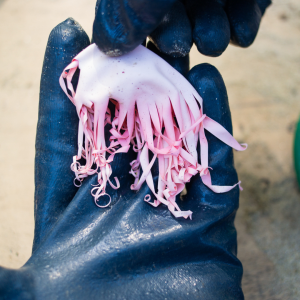Alternatives to Balloons - A Real Reason to Celebrate
Article updated in February 2025
Releasing balloons may seem like a harmless and fun way to celebrate, but as Isaac Newton once said, what goes up must come down! This is no different for balloons that are released into the air, and unfortunately they pose a key threat to the Great Barrier Reef and our oceans as a whole.
Most balloon releases occur in suburban or rural areas. This is because the assumption that being away from coastal areas will reduce the effect of balloons on the marine environment. The Queensland government states that balloons can travel up to 800 km in distance from their original release point; this causes them to become a major environmental hazard.
Thankfully, there are a number of alternatives to balloons that can be used for all kinds of celebrations. Check out our Alternatives to Balloons Fact Sheet for some great ideas.
Released Balloons Turn Into Marine Debris
The Australian Marine Debris Initiative (AMDI) Database confirms balloons are regularly found in marine debris collections. Since 2013, the Database has recorded over 128,960 items under the category “Rubber balloons, balls & toys, elastic straps and bands.” It is estimated that 80% (103,168) are actually balloons.
Balloons, even latex ones, are not ‘biodegradable’, meaning they hang around in the environment as litter for years, posing a threat to wildlife. Many sea turtles mistakenly ingest balloon remnants that look like jellyfish. However, it is not only turtles who struggle. Australia is blessed with an amazingly diverse range of seabirds. Whilst balloon debris is less common than hard plastic debris, a recent study showed if a seabird ingests balloon debris it is 32 times more likely to die.

Burst balloons can look a lot like jellyfish to the unsuspecting marine animal, including turtles
How is Australia Tackling the Balloon Issue?
Thanks to No Balloon Release Australia for verifying this Balloon Release Legislation update (Feb, 2025).
Help Stop Balloon Marine Debris
Thankfully, there are a number of alternatives to balloons that can be used for all kinds of celebrations. Check out our Alternatives to Balloons Fact Sheet for some great ideas.
Tangaroa Blue Foundation, along No Balloon Release Australia, urges other jurisdictions such as NSW and the ACT to include helium balloon releases in their Plastics Plan and include the release of balloons into the environment as littering under their Waste Reduction and Recycling Act.
However, even in states where balloon releases are banned, releases still occur. This shows that the use of helium for inflating balloons needs to be nationally regulated to stop releases at the source.
We need a uniform national ban on the release of balloons and on the sale and use of helium for inflating balloons to stop releases at the source.
Help Preserve Australian Wildlife
Check out and share our ReefClean No Balloon Release Film which displays alternatives to balloons for celebrations and facts about balloon releases.
- Download and use our Alternatives to Balloons Fact Sheet and share with friends and family
- Sign the petition to ban the release of balloons in NSW and the ACT and regulate the sale of balloon helium (PETITION NOW CLOSED)
- Keep up to date with legislation changes and ways to take action by following No Balloon Release Australia
Resources produced were created through the ReefClean program. ReefClean is funded by the Australian Government’s Reef Trust and delivered by the Tangaroa Blue Foundation

